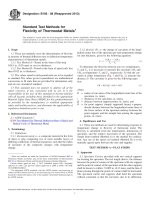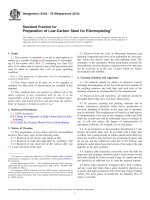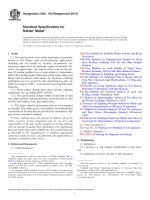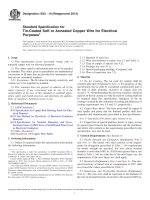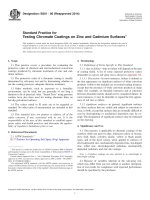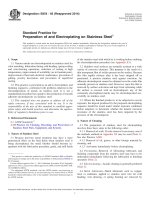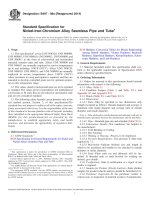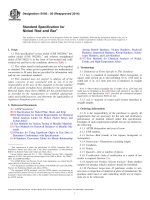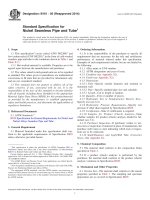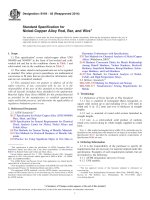Astm b 870 08 (2014)
Bạn đang xem bản rút gọn của tài liệu. Xem và tải ngay bản đầy đủ của tài liệu tại đây (82.71 KB, 3 trang )
Designation: B870 − 08 (Reapproved 2014)
Standard Specification for
Copper-Beryllium Alloy Forgings and Extrusions Alloys
(UNS Nos. C17500 and C17510)1
This standard is issued under the fixed designation B870; the number immediately following the designation indicates the year of
original adoption or, in the case of revision, the year of last revision. A number in parentheses indicates the year of last reapproval. A
superscript epsilon (´) indicates an editorial change since the last revision or reapproval.
B950 Guide for Editorial Procedures and Form of Product
Specifications for Copper and Copper Alloys
E8/E8M Test Methods for Tension Testing of Metallic Materials
E18 Test Methods for Rockwell Hardness of Metallic Materials
E527 Practice for Numbering Metals and Alloys in the
Unified Numbering System (UNS)
E1004 Test Method for Determining Electrical Conductivity
Using the Electromagnetic (Eddy-Current) Method
1. Scope*
1.1 This specification establishes the requirements for
copper-beryllium alloy forgings and extrusions. The following
alloys are specified:
Copper Alloy
UNS No.
C17500
C17510
Beryllium
0.50
0.40
Nominal Composition, %
Cobalt
2.6
Nickel
1.8
1.2 Units—The values stated in inch-pound units are to be
regarded as standard. The values given in parentheses are
mathematical conversions to SI units that are provided for
information only and are not considered standard.
1.3 The following safety hazard caveat pertains to Sections
10 and 11 of this specification:This standard does not purport
to address all of the safety concerns, if any, associated with its
use. It is the responsibility of the user of this standard to
establish appropriate safety and health practices and determine the applicability of regulatory limitations prior to use.
3. General Requirements
3.1 The following sections of Specification B249/B249M
form a part of this specification:
3.1.1 Material and Manufacture,
3.1.2 Sampling,
3.1.3 Number of Tests and Retests,
3.1.4 Specimen Preparation,
3.1.5 Significance of Numerical Limits,
3.1.6 Inspection,
3.1.7 Rejection and Rehearing,
3.1.8 Certification,
3.1.9 Test Reports, and
3.1.10 Packaging and Package Marking.
2. Referenced Documents
2.1 ASTM Standards:2
B194 Specification for Copper-Beryllium Alloy Plate, Sheet,
Strip, and Rolled Bar
B249/B249M Specification for General Requirements for
Wrought Copper and Copper-Alloy Rod, Bar, Shapes and
Forgings
B441 Specification for Copper-Cobalt-Beryllium, CopperNickel-Beryllium, and Copper-Nickel-Lead-Beryllium
Rod and Bar (UNS Nos. C17500, C17510, and C17465)
B601 Classification for Temper Designations for Copper and
Copper Alloys—Wrought and Cast
B846 Terminology for Copper and Copper Alloys
4. Terminology
4.1 For definitions of terms related to copper and copper
alloys, see Terminology B846.
4.2 Definitions of Terms Specific to This Standard:
4.2.1 extrusion, n—a uniform metal shape, long in relation
to its cross-sectional dimensions, produced by forcing a suitably preheated billet or pre-formed shape through an orifice
(die) of the desired cross section.
4.2.2 forging, n—a metal part worked to a predetermined
shape by one or more such processes as hammering, upsetting,
pressing, rolling, and so forth.
1
This specification is under the jurisdiction of ASTM Committee B05 on Copper
and Copper Alloys and is the direct responsibility of Subcommittee B05.02 on Rod,
Bar, Wire, Shapes and Forgings.
Current edition approved April 1, 2014. Published May 2014. Originally
approved in 1996. Last previous edition approved in 2008 as B870 - 08. DOI:
10.1520/B0870-08R14.
2
For referenced ASTM standards, visit the ASTM website, www.astm.org, or
contact ASTM Customer Service at For Annual Book of ASTM
Standards volume information, refer to the standard’s Document Summary page on
the ASTM website.
NOTE 1—Forged and extruded shapes in the context of this specification
are generally construed to be large section products; round, oval, half
round, geometric custom-ordered cross-sections, and asymmetrical metal
shapes. This is to generally differentiate products supplied according to
this document as opposed to forged and extruded “Rod and Bar” in
Specification B441.
*A Summary of Changes section appears at the end of this standard
Copyright © ASTM International, 100 Barr Harbor Drive, PO Box C700, West Conshohocken, PA 19428-2959. United States
1
B870 − 08 (2014)
7.1.2 Copper, given as the remainder, is the difference
between the sum of results of all elements determined and
100 %.
7.1.3 When all elements listed in Table 1 for the alloy
specified in the ordering information are determined the sum of
results shall be 99.5 % minimum.
5. Ordering Information
5.1 Include the following information when placing orders
for product under this specification, as applicable:
5.1.1 ASTM designation and year of issue,
5.1.2 Copper Alloy UNS No. (Section 1),
5.1.3 Temper (Section 8) or condition (Section 11),
5.1.4 Drawing, when required, and
5.1.5 Quantity: number of pieces or pounds.
8. Temper
8.1 The standard temper designations available under this
specification and as prescribed in Classification B601 are
solution heat treated TB00 (A) and precipitation heat treated
TF00 (AT).
5.2 The following requirements are optional under this
specification and shall be included in the contract or purchase
order, when specified.
5.2.1 Tension tests (Section 10),
5.2.2 Special marking or packaging (Specification B249/
B249M),
5.2.3 Inspection (Specification B249/B249M),
5.2.4 Certification (Specification B249/B249M),
5.2.5 Mill test report (Specification B249/B249M),
5.2.6 Finish (Section 14), and
5.2.7 When material is purchased for agencies of the U.S.
government, this shall be specified in the contract or purchase
order, and the material shall conform to the supplementary
requirements as defined in the current issue of Specification
B249/B249M.
9. Physical Property Requirements
9.1 Electrical Conductivity—Product supplied under this
specification shall conform to the conductivity requirements
prescribed in Table 2 after precipitation heat-treatment when
tested in accordance with Test Method E1004.
10. Mechanical Property Requirements
10.1 Hardness—The product furnished under this specification shall conform to the hardness requirements prescribed in
Table 3, when tested in accordance with Test Methods E18.
10.2 Tensile—When specified in the contact or purchase
order, the product furnished shall conform to the tensile
properties in Table 3, when tested in accordance with Test
Methods E8/E8M.
6. Materials and Manufacture
6.1 Materials:
6.1.1 The material of manufacture should be a cast billet
conforming to the chemical composition requirements for the
alloy specified in the ordering information and shall be of such
purity and soundness as to be suitable for processing into the
product prescribed herein.
11. Heat Treatment
11.1 The majority of the product supplied under this specification is in the TF00 (AT) temper. When product is purchased
in the TB00 (A) temper, it should be heat treated to a uniform
temperature in the range from 800 to 900°F (454 to 482°C) for
3 h and then air cooled.
6.2 Manufacture:
6.2.1 The product shall be manufactured by hot working or
extrusion, solution heat-treating, precipitation hardening, and
straightening as may be necessary to meet the properties
specified.
NOTE 2—Special combination of properties may be obtained by special
heat treatments. These requirements shall be agreed upon by the manufacturer or supplier and purchaser.
7. Chemical Composition
12. Dimensions and Permissible Variations
7.1 The material shall conform to the chemical composition
in Table 1 for the alloy specified.
7.1.1 These composition limits do not preclude the presence
of other elements. Limits may be established and analysis
required for unnamed elements by agreement between the
manufacturer and purchaser.
12.1 The dimensions and tolerances for these product forms
shall be those shown on the drawing that forms a part of each
order or as agreed upon between the manufacturer and the
purchaser.
13. Workmanship, Finish, and Appearance
13.1 The product forms shall be of uniform quality and
condition and shall not have laps, cracks, bursts, or other
injurious defects that interfere with normal applications.
TABLE 1 Chemical Requirements
Concentration, %
Element
Beryllium
Cobalt
Nickel
Iron, max
Aluminum, max
Silicon, max
Copper
Copper Alloy UNS No.
C17500
0.4–0.7
2.4–2.7
...
0.10
0.20
0.20
Remainder
13.2 The purchaser shall specify in the order the condition
or finish required, such as, hot worked, hot worked and cleaned
by blasting, pickling, or machining.
Copper Alloy UNS No.
C17510
0.2–0.6
0.3 max
1.4–2.2
0.10
0.20
0.20
Remainder
TABLE 2 Electrical Conductivity
Temper
TF00 (AT)
2
IACS, min, %
45
B870 − 08 (2014)
TABLE 3 Mechanical Properties
Temper Designation
Standard
TB00
Solution Heat-Treated
TF00
Precipitation Hardened
A
Tensile Strength,
ksi (MPa)
Size
Former
Yield Strength,
ksi (MPa)
Rockwell Hardness
B Scale
(A)
All
30–55 (207–380)
10–30 (69–207)
50 max
(AT)
Up to 4 in. incl.
Over 4 in. to 6 in. incl.
Over 6 in. to 8 in. incl.
Over 8 in.
100–130A (690–897)
95–125A (655–863)
90–120A (620–828)
80–100A (550–690)
80–100A (550–690)
75–95A (517–656)
70–90A (483–620)
60–80A (414–550)
92
92
92
90
min
min
min
min
The upper limits are for design guidance only.
14. Test Methods
14.1 Chemical Composition:
14.1.1 The chemical composition shall, in case of
disagreement, be determined in accordance with the applicable
method in the Annex of Specification B194.
14.1.2 Test methods to be followed for the determination of
element(s) resulting from contractual or purchase-order agreement shall be as agreed upon between the manufacturer and the
purchaser.
15. Keywords
15.1 copper beryllium extrusions; copper beryllium forgings; UNS Alloy C17500; UNS Alloy C17510
SUMMARY OF CHANGES
Committee B05 has identified the location of selected changes to this standard since the last issue (B870 - 02)
that may impact the use of this standard. (Approved April 1, 2008)
(1) Under section 1.1 revised Beryllium entry for C17500.
(2) Document was revised to meet the requirements of Form
and Style for ASTM Standards (Guide B950).
ASTM International takes no position respecting the validity of any patent rights asserted in connection with any item mentioned
in this standard. Users of this standard are expressly advised that determination of the validity of any such patent rights, and the risk
of infringement of such rights, are entirely their own responsibility.
This standard is subject to revision at any time by the responsible technical committee and must be reviewed every five years and
if not revised, either reapproved or withdrawn. Your comments are invited either for revision of this standard or for additional standards
and should be addressed to ASTM International Headquarters. Your comments will receive careful consideration at a meeting of the
responsible technical committee, which you may attend. If you feel that your comments have not received a fair hearing you should
make your views known to the ASTM Committee on Standards, at the address shown below.
This standard is copyrighted by ASTM International, 100 Barr Harbor Drive, PO Box C700, West Conshohocken, PA 19428-2959,
United States. Individual reprints (single or multiple copies) of this standard may be obtained by contacting ASTM at the above
address or at 610-832-9585 (phone), 610-832-9555 (fax), or (e-mail); or through the ASTM website
(www.astm.org). Permission rights to photocopy the standard may also be secured from the ASTM website (www.astm.org/
COPYRIGHT/).
3
